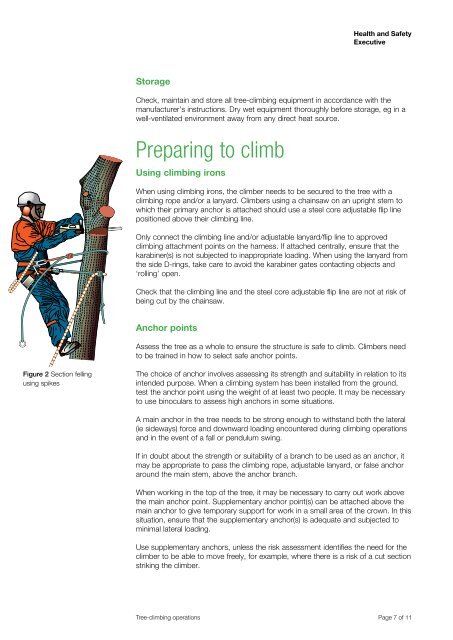Tree-climbing operations AFAG401 - HSE
Tree-climbing operations AFAG401 - HSE
Tree-climbing operations AFAG401 - HSE
You also want an ePaper? Increase the reach of your titles
YUMPU automatically turns print PDFs into web optimized ePapers that Google loves.
Health and Safety<br />
Executive<br />
Storage<br />
Check, maintain and store all tree-<strong>climbing</strong> equipment in accordance with the<br />
manufacturer’s instructions. Dry wet equipment thoroughly before storage, eg in a<br />
well-ventilated environment away from any direct heat source.<br />
Preparing to climb<br />
Using <strong>climbing</strong> irons<br />
When using <strong>climbing</strong> irons, the climber needs to be secured to the tree with a<br />
<strong>climbing</strong> rope and/or a lanyard. Climbers using a chainsaw on an upright stem to<br />
which their primary anchor is attached should use a steel core adjustable flip line<br />
positioned above their <strong>climbing</strong> line.<br />
Only connect the <strong>climbing</strong> line and/or adjustable lanyard/flip line to approved<br />
<strong>climbing</strong> attachment points on the harness. If attached centrally, ensure that the<br />
karabiner(s) is not subjected to inappropriate loading. When using the lanyard from<br />
the side D-rings, take care to avoid the karabiner gates contacting objects and<br />
‘rolling’ open.<br />
Check that the <strong>climbing</strong> line and the steel core adjustable flip line are not at risk of<br />
being cut by the chainsaw.<br />
Anchor points<br />
Assess the tree as a whole to ensure the structure is safe to climb. Climbers need<br />
to be trained in how to select safe anchor points.<br />
Figure 2 Section felling<br />
using spikes<br />
The choice of anchor involves assessing its strength and suitability in relation to its<br />
intended purpose. When a <strong>climbing</strong> system has been installed from the ground,<br />
test the anchor point using the weight of at least two people. It may be necessary<br />
to use binoculars to assess high anchors in some situations.<br />
A main anchor in the tree needs to be strong enough to withstand both the lateral<br />
(ie sideways) force and downward loading encountered during <strong>climbing</strong> <strong>operations</strong><br />
and in the event of a fall or pendulum swing.<br />
If in doubt about the strength or suitability of a branch to be used as an anchor, it<br />
may be appropriate to pass the <strong>climbing</strong> rope, adjustable lanyard, or false anchor<br />
around the main stem, above the anchor branch.<br />
When working in the top of the tree, it may be necessary to carry out work above<br />
the main anchor point. Supplementary anchor point(s) can be attached above the<br />
main anchor to give temporary support for work in a small area of the crown. In this<br />
situation, ensure that the supplementary anchor(s) is adequate and subjected to<br />
minimal lateral loading.<br />
Use supplementary anchors, unless the risk assessment identifies the need for the<br />
climber to be able to move freely, for example, where there is a risk of a cut section<br />
striking the climber.<br />
<strong>Tree</strong>-<strong>climbing</strong> <strong>operations</strong> Page 7 of 11

















